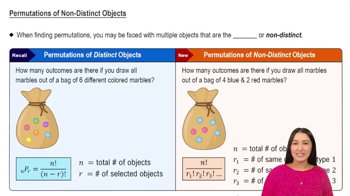Here are the essential concepts you must grasp in order to answer the question correctly.
Objective Function
An objective function is a mathematical expression that defines the goal of an optimization problem, typically in the form of maximizing or minimizing a value. In this case, the objective function is z = 40x + 50y, where x and y are variables representing quantities to be optimized. The values of the objective function are evaluated at specific points, known as corner points, within the feasible region.
Recommended video:
Permutations of Non-Distinct Objects
Feasible Region
The feasible region is the set of all possible points that satisfy the constraints of an optimization problem. It is typically represented graphically as a polygon on a coordinate plane. In this scenario, the feasible region is bounded by the axes and the lines representing the constraints, and the corner points of this region are critical for evaluating the objective function.
Recommended video:
Probability of Non-Mutually Exclusive Events Example
Corner Points
Corner points, or vertices, of the feasible region are the points where the boundary lines intersect. These points are essential in linear programming because the maximum and minimum values of the objective function will occur at one of these corner points. In this problem, the corner points are (0, 10), (6, 8), and (10, 0), and evaluating the objective function at these points will yield the required maximum and minimum values.
Recommended video:

 Verified step by step guidance
Verified step by step guidance Verified Solution
Verified Solution



 7:2m
7:2m